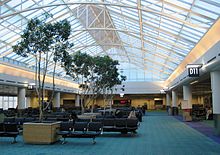Portland International Airport carpet

The carpet at Portland International Airport (PDX) in Portland, Oregon, featured geometric shapes on a teal background, representing the intersection of the north and south runways seen by air traffic controllers from the airport's tower at night. SRG Partnership designed it in 1987, and since then, the carpet has received much media attention.
In 2013, the Port of Portland announced the carpet's replacement with a new pattern conceptualized by the Portland-based firm Zimmer Gunsul Frasca Architects. The announcement generated a social media "phenomenon" and gained attention from local and national news outlets. Removal of the original carpet began in January 2015, with the airport recycling worn portions and making remaining pieces available for sale by local retail vendors.
In 2015 Portland Trail Blazers point guard Damian Lillard released his first PDX carpet colorway on the Adidas D Lillard 1 sneaker.[1] In 2016, Lillard released the colorway on the D Lillard 2,[2] also inspired by the carpet.
Background

To reduce the amount of noise created by people walking across hard terminal floors, the Port of Portland contracted SRG Partnership to design new carpet for PDX in 1987. The SRG principal and co-designer of the carpet, John Schleuning, visited several airports before deciding what to create for the carpet at Portland International Airport. SRG steered away from the earth tones traditionally used by airports in the 1980s, incorporating blue and green into their design early on and hoping to evoke "northwest to the core."[3] Its pattern featured geometric shapes on a teal background,[4] an abstract depiction of the intersecting north and south runways seen by air traffic controllers from the airport's tower at night.[3][5][6] Several acres of the carpet were installed by the early 1990s.[3]
Over time, the carpet gained a cult following. Multiple social media accounts were dedicated to it and more than 20,000 pictures were posted to its official Instagram hashtag, #pdxcarpet.[5] Airport visitors often took pictures of their feet on the carpet.[6]
The original carpet design received a positive reception by Portland residents and airport visitors, eventually reaching "local icon" status.[5] Its pattern was used on a variety of products, including bicycle helmets, socks and T-shirts.[5] In 2013, Portland Monthly published "Ode on a Carpet", a poem inspired by T. S. Eliot's "The Hollow Men" (1925).[5][7] In September 2014, PDX installed an 11 ft × 16 ft (3.4 m × 4.9 m) collage made of the carpet.[5]
Replacement

A $13 million replacement[8] of the airport's carpet was announced in 2013, sparking social media attention that was picked up by local and national media outlets.[6] The Port of Portland received a large number of comments from local residents who were concerned about the original carpet's future. Annie Linstrom, a spokesperson for the port district, confirmed they were investigating recycling options and considering giving away portions to locals as keepsakes.[3][5] She also said that the Port of Portland "understand[s] that people have an emotional connection to the carpet."[3] In December 2013, Portland Monthly published a preview of the redesign, which was conceptualized by Zimmer Gunsul Frasca Architects of Portland. The magazine reported that the new design included "mood-enhancing colors and a new repeating pattern, while clearly preserving key elements" from the original carpet.[4] Linstrom said, "The Port hopes that travelers will grow to appreciate elements of the new carpet design over time, just as much as the old."[4]

In January 2015, removal of the nearly-30-year-old carpet began in front of a crowd of airport employees and media. The Port of Portland's chief operating officer said: "Normally we do these ribbon cuttings when we’re introducing a new thing, but it’s actually the reverse of that in removing the old carpet. We’re going to miss the carpet and we appreciate the community and the love of this carpet."[6] Any businesses that were able to receive, stockpile, and redistribute carpet could request 1,000 square yards (840 m2) from the Port of Portland.[5][6]
The airport's new carpet design features natural and man-made shapes found around the airport—referencing flight, nature, and structures such as airplane wings, hiking trails, leaves, runways, and waterways.[4][5][6] According to Oregon Public Broadcasting, the old and new carpet designs are similar in appearance "to the untrained, out-of-towner eye."[6] Installation was scheduled to continue through November 2015.[6] Local firm Hennebery Eddy Architects is overseeing its installation, having been contracted in June 2013 to select materials and manage logistics.[4] The new carpet is made of materials from recycled carpet and plastic bottles and jars.[5]
References
- ^ "D Lillard 1 sneaker, PDX Carpet edition, appears to be on the way". The Oregonian. May 19, 2015. Retrieved 2017-12-12.
- ^ "adidas D Lillard 2 PDX Carpet Release Date | SneakerNews.com". Sneaker News. 2016-06-08. Retrieved 2016-09-05.
- ^ a b c d e Johnson, Cari (December 20, 2013). "A Brief History of the PDX Airport Carpet". Portland Monthly. Portland, Oregon: Sagacity Media. ISSN 1546-2765. Retrieved January 25, 2015.
- ^ a b c d e Johnson, Cari (December 12, 2013). "A Peek at PDX Airport's New Carpet". Portland Monthly. Retrieved January 25, 2015.
- ^ a b c d e f g h i j Barney, Alicia (December 16, 2014). "In Portland, It's Curtains for an Airport Carpet". The New York Times. Retrieved January 25, 2015.
- ^ a b c d e f g h Duffy, Lizzy (January 23, 2015). "Portland International Airport Commemorates PDX Carpet With Ripping Ceremony". Oregon Public Broadcasting. Retrieved January 25, 2015.
- ^ "Ode on a Carpet, by T.S.A. Eliot". Portland Monthly. December 2, 2013. Retrieved January 26, 2015.
- ^ Johnson, Steve (January 23, 2015). "PDXNext: Portland International Airport Improvements Planned" (PDF) (Press release). Port of Portland. Retrieved April 5, 2015.
External links
- Only in Portland Would the Airport's Carpet Reach Cult Status (January 23, 2015), NBC News
